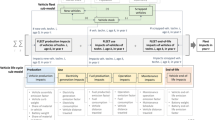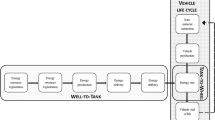Abstract
Under consideration of the overall Life Cycle Inventory Analysis (LCI) results generated in the first step of this study and based on the February 1999 edition of ISO/DIS 14042 the Life Cycle Impact Assessment (LCIA) for the introduction of various emission control measures for freight traffic heavy duty vehicles in Germany was determined. For the examination of the several mandatory elements 11 impact categories related to the freight traffic and the LCI results were focussed, the LCI results were designed to these impact categories and with characterization factors of the 11 selected and recognized characterisation models the categories indicator endpoints were quantified. The optional elements for normalization and weighting were added to the analysis. Two reference values are used for normalizing the category indicator results. For the weighting step 8 recognized evaluation methods were selected with the aim to aggregate the LCI results to an overall value. The results enable plausible conclusions with regard to the ecological advantages and disadvantages of the use of each analysed emission control technology for heavy duty diesel vehicles. As no perfectly clear ranking can be distinguished for evaluation of the generated results and no correlation can be established to the economical effects of the corresponding measurements, it is necessary to complete the currently existing recommendation from the ISO/DIS-Standards with further parameters.
Similar content being viewed by others
Abbreviations
- AK:
-
Spent nuclear fuel in underground repositories
- AKW:
-
Nuclear power plant
- Eq:
-
Equivalent
- DBM:
-
Dead biomass
- DIMB:
-
Thick-walled metallic parts, rubble
- DüMB:
-
Thin-walled metallic parts, rubble
- ECU:
-
European Currency Unit
- ELU:
-
Environmental Load Units
- EU3M:
-
Scenario for introduction of diesel engines of exhaust gas class EURO 3
- ExP:
-
Exposed persons in nuclear power plant
- HC:
-
Hydrocarbons
- K:
-
Scenario for diesel fuel parameter change
- CQR:
-
Concept of Quality target Relations (‘molar method’)
- MEA:
-
Monoethanolamine
- MVA:
-
Waste incineration plant
- n. c.:
-
Not accounted for
- S:
-
Sulfur
- SA:
-
Products of fission and activation (not including tritium)
- SCR:
-
Selective catalytic reduction
- EPSU:
-
Environmental Pollution Source Units
- SKW-DeNOx:
-
SCR system for NOx reduction from hard-coal fired power plants
- SMA:
-
Weakly and moderately active solids in underground repositories
- SMVA:
-
Non radioactive hazardous waste incineration plant
- SOA:
-
Stratospheric ozone depletion
- SP:
-
Sensitivity test
- PLC:
-
Product life cycle
- EBP:
-
Ecological burden points
- ERP:
-
Ecological relief points
- V1 – V4 :
-
scenarios for introduction of exhaust-gas side measures (see [2])
References
DIN (1997): Environmental management – Life Cycle Assessment – Principles and framework (EN ISO 14040). Beuth, Berlin
Bárzaga Castellanos L, Neufert R, Markert B (2001): Life Cycle Assessment for the Implementation of Emission Control Measures for the Freight Traffic with Heavy Duty Vehicles in Germany, Phase 1: Life Cycle Inventory Analysis. Int J LCA 6 (4) 231–242
DIN (1999): Environmental management – Life Cycle Assessment – Life Cycle Impact Assessment (ISO/DIS 14042). Beuth, Berlin
VDI (1995): Kumulierter Energieaufwand, Begriffe, Definitionen, Berechnungsmethoden (VDI 4600 Entwurf). Beuth, Berlin, Düsseldorf
Lindfors LG et al. (1995): Nordic Guidelines on Life Cycle Assessment (Nord 1995:20). Nordic Council of Ministers, Copenhagen, Denmark
von Bortel R (1997): Analyse ausgewählter Emissionen von Dieselmotoren in Abhängigkeit von der Kraftstoffzusammen-setzung, Diss. Technische Universität Carolo-Wilhemina zu Braunschweig. Paper flyer, Clausthal-Zellerfeld
Gebler W (1992): ökobilanzen in der Abfallwirtschaft, 2nd revised edition. Erich Schmidt, Bielefeld
Wehowsky P et al. (1994): Strom- und Wärmeerzeugende Anlagen auf fossiler und nuklearer Grundlage, IKARUS Report 4-06. Jülich Research Center, Jülich
Braunschweig A, Müller-Wenk R (1993): ökobilanzen für Unternehmungen: Eine Wegleitung für die Praxis. Paul Haupt, Bern, Stuttgart, Vienna
Steen B, Ryding SO (1992): The EPS Enviro-Accounting Method. An application of environmental accounting principles for evaluation and valuation of environmental impact in product design. Swedish Environmental Research Institute (IVL, IVL Report No. B 1080), Göteborg, Sweden
Braunschweig A, Förster R, Hofstetter P, Müller-Wenk R(1994): Evaluation und Weiterenrwicklung von Bewertungsmethoden fur ökobilanzen – Erste Ergebnisse, IWö Discussion Contribution No. 19. Institut für Wirtschaft und ökologie, St. Gallen
Böring JA (1994): Methoden betrieblicher ökobilanzierung, Diss. Universität Augsburg, Hochschulschriften Volume 16. Metropolis, Marburg
Deutscher Bundestag, Enquete-Kommission zum Schutz des Menschen und der Umwelt (Hrsg) (1995): Studienprogramm Umweltverträgliches Stoffstrommanagement, Volume 1, Konzepte. Economica, Bonn
Fasold, H. G.; Freitag, F.; Heymer, D. and van Heyden, L. (1994): Erdgastransport, -speicherung und -verteilung, IKARUS Report 4-14. Jülich Research Center, Jülich
Hedden K, Jess A (1994): Bereich Raffinerien und ölveredelung, IKARUS Report 4-04. Jülich Research Center, Jülich
DIN (1999): Environmental management-Life Cycle Assessment – Life cycle interpretation (ISO/DIS 14043), Beuth, Berlin
Author information
Authors and Affiliations
Corresponding authors
Additional information
Phase 1: Life Cycle Inventory Analysis. Int J LCA vn6 (4) 231–242(2001) Phase 3: Life Cycle Interpretation (DOI: http://dx.doi.oro/10.1065/ Ica2000.12.044.3)
Rights and permissions
About this article
Cite this article
Bárzaga-Castellanos, L., Neufert, R. & Markert, B. Life cycle assessment for the implementation of emission control measures for the freight traffic with heavy duty vehicles in Germany. Int J LCA 6, 285–292 (2001). https://doi.org/10.1007/BF02978790
Received:
Accepted:
Issue Date:
DOI: https://doi.org/10.1007/BF02978790




